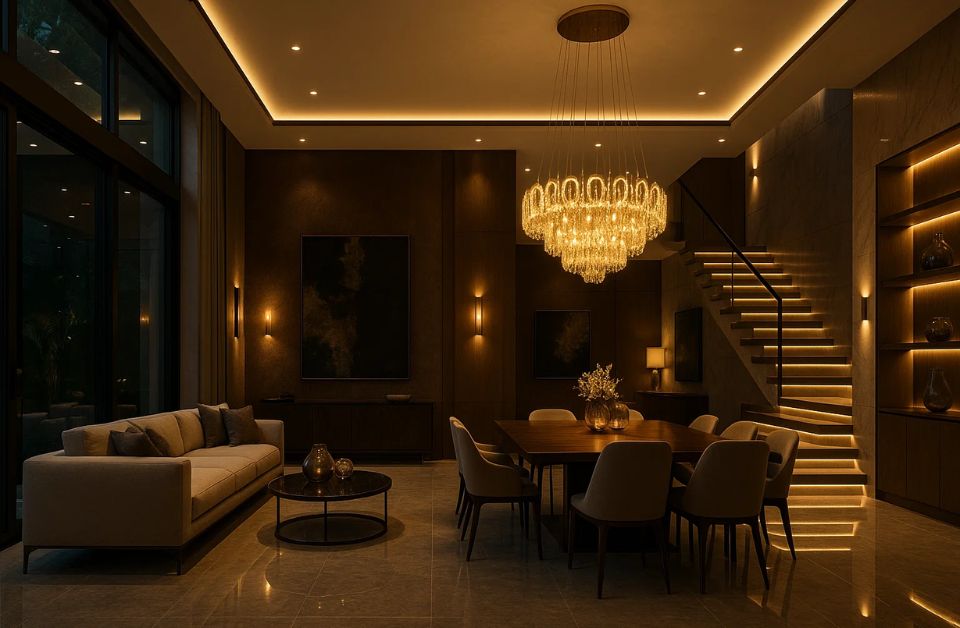Lighting is more than just illumination; it is an integral part of modern architecture. Architectural lighting solutions have evolved into powerful tools that shape how we experience spaces, highlight design elements, and create moods. Whether it’s a luxury residence, commercial office, hospitality project, or an urban landmark, the right lighting brings design concepts to life.
In today’s world, innovation, energy efficiency, and customization are driving the future of architectural lighting. This complete guide will walk you through modern design principles, the latest technologies, and practical applications to help you understand why architectural lighting is at the heart of contemporary design.
What is Architectural Lighting?
Architectural lighting is the strategic integration of light with architecture. It ensures that both functionality and aesthetics are addressed, enhancing the visual experience of a space. Unlike generic lighting, architectural lighting considers:
- Form – How light complements design elements.
- Function – Ensuring spaces are lit for safety, productivity, and comfort.
- Emotion – Creating moods and atmospheres with light intensity, color, and placement.
Types of Architectural Lighting Solutions
Modern projects often blend multiple lighting types for the perfect balance:
- Ambient Lighting – General illumination to make a space usable.
- Task Lighting – Focused light for specific activities like reading or cooking.
- Accent Lighting – Highlights architectural details, artwork, or textures.
- Decorative Lighting – Fixtures that serve as both light sources and design elements.
Key Innovations in Architectural Lighting
Modern architectural lighting goes far beyond traditional bulbs. Here are the leading innovations:
- LED Technology
- Energy-efficient, long-lasting, and available in multiple color temperatures.
- Offers design flexibility with strips, panels, spotlights, and track lighting.
- Tunable White & Human-Centric Lighting
- Adjusts color temperature to mimic natural daylight.
- Supports circadian rhythms, improving productivity and well-being in offices, schools, and healthcare spaces.
- Smart Lighting Systems
- DALI and DMX controls for advanced dimming, zoning, and scene creation.
- Integration with IoT and building management systems.
- Custom Fixtures
- Bespoke LED fixtures designed to match specific architectural aesthetics.
- Blends seamlessly into luxury residences, temples, heritage sites, or modern villas.
- Sustainable Lighting
- Use of solar-powered fixtures, energy-saving LEDs, and recyclable materials.
- Helps meet green building certifications like LEED and GRIHA.
Architectural Lighting for Different Applications
- Residential Projects
- Track lighting and LED strip lighting for minimalist interiors.
- Accent lighting to highlight art, textures, and false ceilings.
- Warm tones for bedrooms and living spaces to enhance comfort.
- Commercial Spaces
- Office lighting consultants recommend task-oriented designs with glare-free luminaires.
- Human-centric lighting improves employee focus and reduces fatigue.
- Hospitality and Hotels
- Ambient LED lighting creates mood-enhancing environments.
- Outdoor architectural facade lighting highlights the property’s unique identity.
- Custom fixtures differentiate luxury villas, resorts, and high-end hotels.
- Outdoor & Landscape
- Architectural outdoor lighting improves safety while adding beauty.
- Bollard lights, pathway lights, and garden uplights enhance exteriors.
- Solar landscape lights combine sustainability with elegance.
- Facade and Heritage Projects
- Facade lighting solutions bring iconic buildings to life at night.
- Custom LED spotlights highlight temple carvings and historic architecture.
- DMX-enabled lighting allows dynamic color-changing effects for festivals.
Benefits of Architectural Lighting Solutions
Choosing the right lighting strategy brings multiple advantages:
- Enhances Aesthetics – Highlights design features and adds visual drama.
- Improves Functionality – Ensures spaces are comfortable and productive.
- Energy Efficiency – LED technology reduces power consumption significantly.
- Flexibility & Control – Smart systems allow scene setting for different times and moods.
- Increased Safety – Proper lighting improves navigation and reduces accidents in public areas.
Common Architectural Lighting Options
Architectural LED Strip Lighting
- Perfect for cove ceilings, staircases, and furniture integration.
- Offers continuous lines of light for a modern look.
Architectural Track Lighting
- Flexible solution for adjustable spotlighting.
- Popular in showrooms, offices, and luxury homes.
Architectural Outdoor Lighting
- Includes facade, bollard, and landscape fixtures.
- Ensures durability with weather-resistant materials (IP65 rated).
Mistakes to Avoid in Architectural Lighting
Even in high-end projects, lighting mistakes can reduce design impact. Some to avoid:
- Over-lighting spaces, causing glare and discomfort.
- Ignoring color temperature consistency across fixtures.
- Using generic solutions instead of custom-designed luminaires.
- Poor placement that hides or washes out architectural details.
How to Choose the Right Architectural Lighting Company?
When selecting a lighting partner, consider:
- Experience in Architectural Projects – Look for a company with proven expertise.
- Customization Capabilities – Ability to design fixtures tailored to your project.
- Product Quality – Ensure durability, energy efficiency, and high CRI (Color Rendering Index).
- Advanced Controls – Compatibility with DALI, DMX, and IoT systems.
- Client Portfolio – Review past projects in residential, commercial, hospitality, and heritage sectors.
The Future of Architectural Lighting
The coming years will see more integration of AI and smart controls. Expect:
- Adaptive Lighting – Automatically adjusting brightness and tone based on occupancy and natural daylight.
- Interactive Designs – Lighting installations that respond to movement, music, or environmental data.
- Greater Focus on Sustainability – Expansion of solar-powered and recyclable fixtures.
- Personalized Experiences – Custom lighting scenes for homes, hotels, and urban spaces.
Final Thoughts
Architectural lighting solutions are no longer an afterthought; they are a central part of design innovation. From enhancing interiors and facades to transforming landscapes, the right lighting brings beauty, function, and sustainability together.
By combining LED innovation, smart systems, and custom design, companies like Nirvana Lighting are shaping the future of architectural illumination. Whether it’s a luxury villa, commercial office, hotel, or heritage project, thoughtful lighting design ensures every detail shines.

